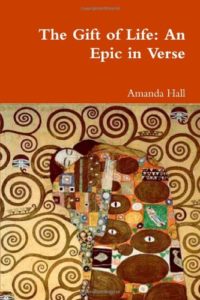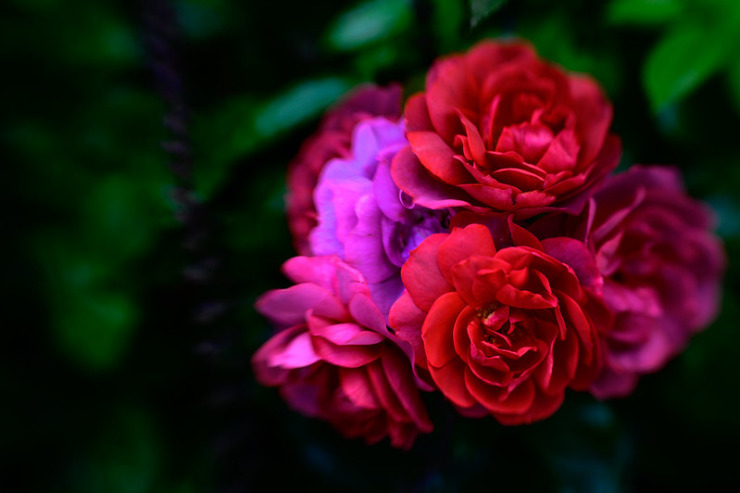Poet Amanda Hall has a gift for writing sonnets. Such a gift, in fact, that she’s created an epic story of unrequited and rechanneled love and told it in sonnet form — as in 500 sonnets.
This is no easy feat. Writing a sonnet requires poetic discipline. The English sonnet (think William Shakespeare) is a poem of 14 lines: three quatrains of four lines each, concluding with couplet. It has a rhyme scheme of ABAB / CDCD / EFEF / GG. Traditionally, the sonnet is written in iambic pentameter; each line has 10 syllables in five pairs, with the stress on the second syllable.
The sonnet is the poetic form most associated with love (thanks again to Shakespeare and also Robert and Elizabeth Barrett Browning). It is an intensely personal poem, written for a reading audience of one. It shares characteristics with the love song. In fact, “sonnet” means “little song.”
Imagine the effort required to tell an extended story, an epic, in not only verse but sonnet form. That’s what Hall has done with The Gift of Life: An Epic in Verse. And she’s done it using rather prosaic narrative elements that become something almost fabulous in sonnet form.
Anne Hart is a writer. She longs for love, but it seems that it’s not to be. Then she sees Sean Hughes, and it’s love at first sight. Sean, a college professor, sees Anne, and falls deeply in love as well. But there’s a problem. Sean is happily married, with two sons. And his devotion to his wife and family precludes unfaithfulness. They see each other but never speak. She attends a lecture he gives and sees his wedding ring.
Sean knows he cannot break his vows, desert his wife, and abandon his children, no matter what personal agony he must endure.

A sadness such as he had never felt
Before, the isolation of a dunce,
Combined with joy to make his sadness melt.
Alone again he would not ever be;
In Anne his very soul had found a friend,
A mate with the same sense of life as he,
A passion born of joy without an end.
That she was real both pained and gave him strength—
A greater loneliness he’d now endure:
To raise a family’s time of no short length,
And he would not meet Bea as man impure.
What Anne did give had origin above,
For knowing her increased his store of love.
Anne channels her love for Sean into — of all things — writing the texts for greeting cards. But the texts reflect and amplify her love, touching people in ways they’ve never been touched before. She starts a greeting card business with her friend Matt, an illustrator. An entrepreneur named Phil is so taken with the cards that he proposes an online greeting card venture, and business explodes.
The greeting cards gain an immediate and large audience because people sense they speak to the good, the true, the pure, and the eternal. That sets up the almost inevitable reaction from the elites.

Amanda Hall
Enter one Sally Slash, the critic. She decides she will destroy this greeting card business, because it holds nothing that appeals to her understanding of art and artists. “If the art world is skewed it is because / It makes art no sane person wants to see.” Championing this (insane) understanding of writing and art, Sally incites the online social media mob, which rants in its outrage. And then, unexpectedly, cancel culture meets opposition. The battle is joined.
Hall is the author of numerous works of poetry, fiction, theater, and criticism. She’s previously published another epic in verse, The Laughing Pen: An Epic Satire in Heroic Meter. Her poetry collections include Endless Wait Now: 100 Love Sonnets, One Hundred Marian Prayers for All Occasions, A Vatican City Tribute to Thirty Saints, The Dancer in the Hall, The Nude Mistaken for Porn, The Guitar in the Other Room, The Calendar to Cherish: A Year in Meditation, Street Writings from the East Coast, Kung Fu Kitty at Eastern Poetry, The Poet, The Clown, Kung Fu Kitty in the Kitchen, and several volumes of The Morality Plays, among many other works. A published member of the Society of Classical Poets, she lives in Florida.
The battle between the temporal and the eternal is what makes The Gift of Life an epic, and it may well be an epic for our time. Beyond the story it tells, it becomes an exploration and meditation on art, artists, contemporary life and culture, and what endures.
Photo by NathalieSt, Creative Commons, via Flickr. Post by Glynn Young.
__________________________

“I require all our incoming poetry students—in the MFA I direct—to buy and read this book.”
—Jeanetta Calhoun Mish
- Poets and Poems: Katie Kalisz and “Flu Season” - April 15, 2025
- Poets and Poems: Michelle Ortega and “When You Ask Me, Why Paris?” - April 10, 2025
- Robert Waldron Imagines the Creation of “The Hound of Heaven” - April 8, 2025

L.L. Barkat says
Sounds remarkable. What a feat!
(Is it hard to concentrate on the story, given the sonnet sequence form?)
Glynn says
Initially. But then you catch the rhythm and flow, and it becomes like reading a story.
Megan Willome says
A story told through poems is becoming my favorite of forms.